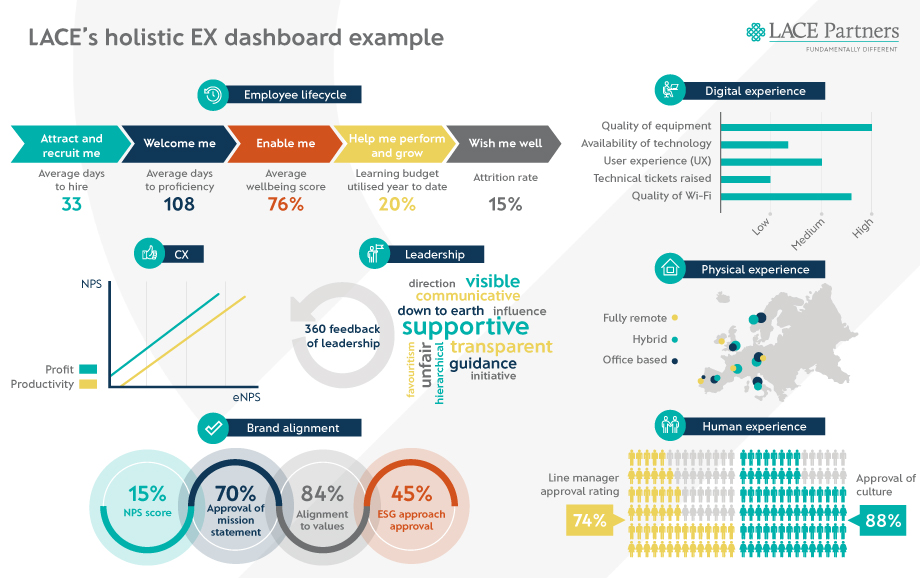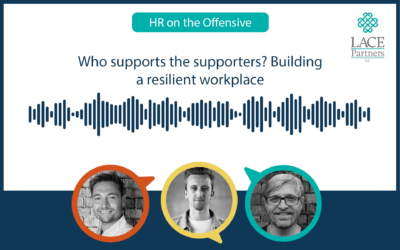The goal for our employee experience revolution campaign is to empower Chief People Officers (CPOs) to have commercial conversations about performance and experience. The relationship between employee experience (EX), productivity and business outcomes is well understood, but how can organisations demonstrate this at board level?
At LACE, we believe that CPOs who are obsessed about holistic employee experience need data and insights to demonstrate the importance to their C-suite peers and maximise the return on their investments in EX.
What does a data-driven business model for employee experience look like?
At LACE, we talk a lot about how you can quantify the business value of EX and like all big investments it starts with a business or value case. A common pushback for investment in employee experience is a lack of tangible value, so we’re here to change this.
Start with outcomes and measure what matters
To ensure you are measuring what matters, start with the business outcomes you and the organisation want to see. That could be an increase in sales performance, Net Promoter Score (NPS), improved revenue or reduced cost. Avoid the temptation to measure everything that’s interesting and focus on narrowing it down to key measures with proven statistical significance to your chosen outcomes.
Don’t restrict yourself to measures that will only resonate with HR – combining HR, employee listening and operational business data is a great way of demonstrating the connection between people, workforce and bottom line value.
Our holistic model for employee experience explains how organisations need to look beyond moments within lifecycle stages to also consider the digital, human and environmental factors influencing employees. Quality of leadership, alignment to your organisation’s brand and customer centricity all have key roles to play.
Each of these intersecting factors has a blend of ‘easier to demonstrate’ and ‘less easy to demonstrate’ success metrics and insights to bring to your board. To get buy-in, it’s important to start with the levers that have the best correlation with human capital driven productivity.
There is no ‘one size fits all’ answer to the right list of metrics, but you can hone your own approach by understanding your workforce and your business goals. In this visual, we give you a few examples of metrics you can measure across our holistic model.
Holistic EX dashboard

*In this example the assumption is that each metric had been statistically proven to have an impact on business performance before being included in the dashboard
Form hypotheses
Once the outcomes have been clearly identified, then you can move to creating hypotheses to test. Think about the likely impact on your holistic experience metrics if the business outcomes are achieved. It can help to use a simple framework to ensure this is expressed as a relationship between variables, for example:
If [people experience measure] [increases / decreases] then [business outcome] [increases / decreases]

If [employee engagement] [increases] then [customer satisfaction] [increases]
Follow statistical good practice to test your hypotheses
Sample size is critical
A large sample size increases the likelihood that the results are representative of the full population and can be extrapolated with a reduced risk of bias or inaccuracy, and that they would be repeatable if the analysis was run again.
Segment your data
Break down your population into key segments or personas to identify more nuanced patterns and insight. It’s critical to understand whether the relationship between the experience and business outcomes applies across the whole population or specific personas / workforce segments.
Correlation does not equal causation
This is probably the best-known maxim about statistics! Simply put, a relationship between two measures does not mean that one is causing the other and you may need to dig deeper to understand what is actually happening.
Disproving hypotheses is useful
Proving non-correlation is great for dispelling misconceptions and in some cases can be as useful an exercise as establishing connections between variables.
Correlation is good, projection is better
Go beyond establishing a relationship and model the impact of what will happen if you improve / change the experience. If a metric improves by 5% what will be the impact on the business outcome? This gives decision makers clear evidence to act on.
Communication
Think about your audience – unless they are all statisticians you will need to use accessible language to convey the results of your analysis. For example:
If employee engagement increases by 2% customer satisfaction may increase by 6%
Scrutinise the ethical implications
Critically review your analytical and data collection methods, ensuring you have a legitimate business purpose for doing so, anonymising sensitive data and ensuring that access to data (particularly with drill downs and filters) is appropriately restricted.
Use these insights at the Board to drive decision making
Demonstrating the ‘hard facts’ about the holistic experience and developing true insights to show the impact an investment in EX can have on tangible business outcomes will enable CPOs to shift the dial and prove to the board it is a no brainer to invest in the employee experience.
Many organisations start with a HR dashboard which incorporates some EX metrics, but with a holistic approach you can begin to tie in influencing factors which can be critical in truly understanding your employees, their experience and the relationship to your organisational success to make better informed decisions at the board.
If you are looking for support in how you raise the value of measuring your EX metrics at the board level, or you want to stress test what you are looking to measure, let us know by filling in the form below; we’ll be happy to help!






